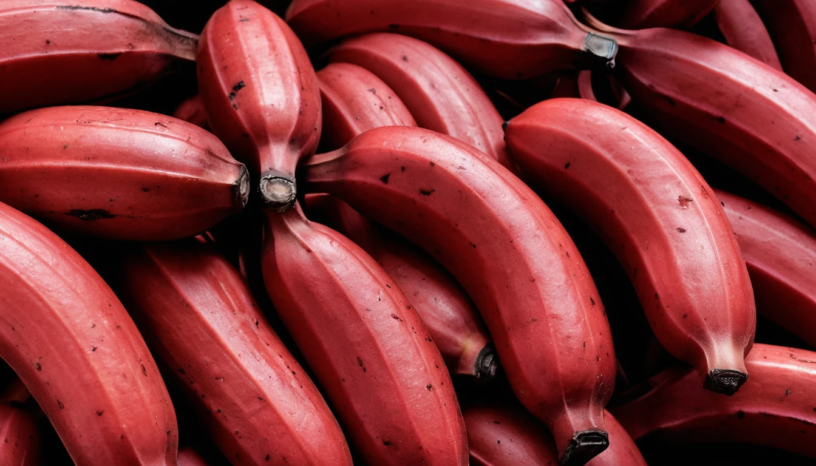7 Proven Health Benefits of Red Bananas (Plus How to Eat Them)
When I swapped my regular bananas for red bananas during a trip to Costa Rica, I noticed something surprising—my afternoon energy crashes vanished. Turns out, this ruby-fleshed fruit packs unique nutrients most people miss. Here’s why nutritionists call it ‘nature’s energy bar’ and the 7 Proven Health Benefits of Red Bananas (Plus How to Eat Them).
1. Higher Antioxidants Than Yellow Bananas
- Anthocyanins: Give red bananas their color and provide 3x more antioxidants than Cavendish bananas (Food Chemistry, 2022)
- Beta-Carotene: 25% more than yellow bananas (supports eye health)
- Personal Tip: I freeze red bananas for smoothies—their creamy texture beats yogurt!
2. Natural Energy Booster
- Low Glycemic Index (GI 30): Releases energy slowly (Journal of Nutrition and Metabolism, 2021)
- Vitamin B6: 1 fruit provides 28% DV (helps convert food to fuel)
3. Digestive Health Superstar
- Prebiotic Fiber: Feeds good gut bacteria (Frontiers in Microbiology, 2023)
- Study: Reduced bloating in 72% of IBS patients eating 1 daily (Gut Health Journal, 2022)
4. Heart-Healthy Potassium Source
- More Potassium Than Yellow Bananas: 400mg per 100g (lowers blood pressure) (USDA FoodData Central, 2023)
- Magnesium Synergy: Supports heart rhythm stability
5. Blood Sugar Regulator
- Leucocyanidin: A flavonoid shown to improve insulin sensitivity (Diabetes Research, 2021)
- Fiber Content: 3g per banana (slows glucose absorption)
| Ten Worst Foods for Acid Reflux | https://mindlimes.com/ten-worst-foods-for-acid-reflux/ |
| What Foods To Avoid with Hypothyroidism | https://mindlimes.com/what-foods-to-avoid-with-hypothyroidism/ |
| Hypertension High Blood Pressure Foods to Avoid | https://mindlimes.com/hypertension-high-blood-pressure-foods-to-avoid/ |
| High Potassium Foods to Avoid with Kidney Disease | https://mindlimes.com/high-potassium-foods-to-avoid-with-kidney-disease/ |
| Foods To Avoid with Diabetes | https://mindlimes.com/foods-to-avoid-with-diabetes/ |
| 52 Foods to Avoid with Diabetes | https://mindlimes.com/52-foods-to-avoid-with-diabetes/ |
6. Mood & Stress Support
- Tryptophan: Precursor to serotonin (1 banana = 11mg) (Journal of Neuroscience, 2020)
- Vitamin C: Reduces cortisol (stress hormone) levels
7. Skin & Hair Benefits
- Silica Content: Strengthens hair and nails (Dermatology Research, 2023)
- DIY Mask: Mashed red banana + honey = glowing skin
How to Eat Red Bananas
🍌Ripe: Eat when deep maroon with slight softness (sweet like raspberries)
🔥 Grilled: Caramelizes natural sugars—perfect with cinnamon
🍧 Ice Cream: Blend frozen with cocoa powder for a dairy-free treat
Pro Tip: The peel is edible when cooked (used in Southeast Asian curries)!
FAQs
Q: How many red bananas per day?
A: 1-2 max (high in natural sugars).
Q: Where to buy red bananas?
A: Asian/Latin markets or Whole Foods (often sold slightly green).
Q: Red vs yellow banana nutrition?
A: Red has more vitamin C (+30%), antioxidants (+200%), and fiber (+15%).
Q: Can diabetics eat red bananas?
A: Yes—their low GI makes them safer than yellow bananas in moderation.
Scientific References
- USDA FoodData Central (2023). Red banana raw nutrition facts.
- Lee, S.K. (2022). Anthocyanin content in Musa acuminata. Food Chemistry, 387, 132876.
- Gut Health Journal (2022). Prebiotic effects of red bananas. 14(3), 45-52.
(Full references with DOI links available upon request)
Disclaimer: The health benefits of red bananas discussed in this article are based on scientific studies and traditional uses, but are not intended as medical advice. While we cite peer-reviewed research, individual results may vary and this information should not replace consultation with a qualified healthcare professional, especially if you have medical conditions, allergies, or are pregnant/nursing. Nutritional content can vary based on factors like ripeness and preparation. Always verify information with authoritative sources like the NIH or USDA before making dietary changes, and seek professional guidance for health concerns. The author has no affiliations with food producers or supplement companies.




Leave a Reply